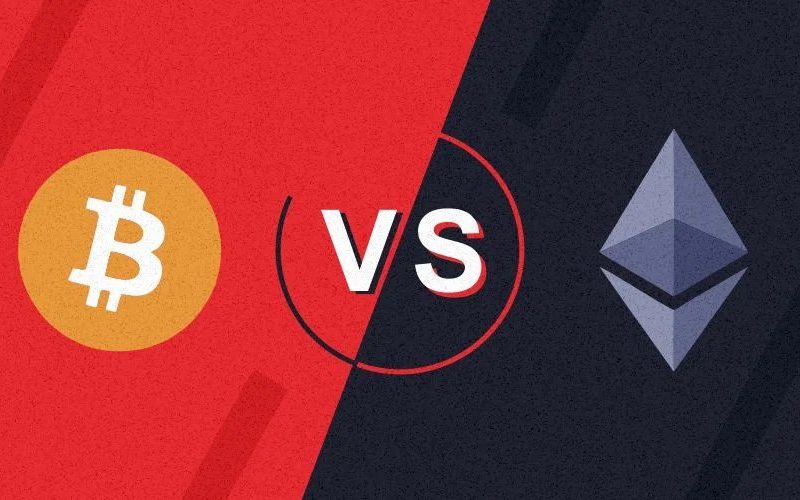ETH, the Ethereum network’s cryptocurrency, is the second most widely used digital token following bitcoin (BTC) (BTC). It’s only reasonable to draw comparisons with Ether and Bitcoin, the largest cryptocurrency on market capitalization. Many things about ether or bitcoin are the same: they’re both digital currencies that can be bought and sold on exchanges & stored in a variety of wallets.
Because neither of these tokens is issued nor governed by a central body, they are considered decentralized. Both rely on the decentralized ledger technology called blockchain for their operations. We’ll compare and contrast bitcoin and ether in the sections that follow. For the most precise and accurate information regulating bitcoin and other cryptocurrencies, you can always visit cfds-trader.com
Basics of the Bitcoin Currency
A digital ledger public ledger is all that exists instead of actual bitcoins. There had been previous attempts at an online currency before we created bitcoin. Nevertheless, bitcoin is by far the most successful of these early initiatives, and it is considered a precursor to nearly every cryptocurrency created in the last decade.
Decentralized virtual currencies have been increasingly popular among regulators as government agencies in recent years. However, Bitcoin has carved out its niche and continues to survive with the monetary system despite being routinely analyzed and disputed, despite not being an officially recognized method of payment of store of value.
The Fundamentals of Ethereum
The use of blockchain technology extends beyond only creating digital money. Open-ended decentralized software platform Ethereum was announced in April of 2015 and is the largest and very well. Smart contracts and decentralized applications can be developed and deployed on Ethereum without the need for third-party interference, control, or downtime. Developers can create and execute distributed apps using Ethereum’s programming language, which runs on a blockchain.
When it comes to using Ethereum, the possibilities are endless because of its cryptographic asset, ethereum (commonly abbreviated as ETH). Ethereum staged an ether presale in 2014 to a roaring success. Developers utilize ether to construct and execute applications on the Ethereum network because it fuels running commands. When it comes to ether, there are two primary uses: trading as digital money on exchanges like other cryptocurrencies and using it to power apps on the Ethereum network.
Differences between the two
Bitcoin and Ethereum use distributed ledgers or cryptography in similar ways, yet they are fundamentally different. An executable program can be attached to Ethereum network transactions, while the data attached to Bitcoin transactions is to keep track of things like transaction times. Besides block time, there are variations in the algorithms they utilize and how they conduct transactions (ethereum transactions are confirmed in seconds, while bitcoin transactions take minutes).
A cryptocurrency such as bitcoin was founded as competition for national currencies, while Ethereum exists for the sole purpose of being a platform for immutable programmable contracts and applications. Cryptocurrencies such as Bitcoin (BTC) and Ethereum (ETH) exist to facilitate and monetize the Ethereum network contract and decentralized application (app) platforms. However, ETH’s primary goal is not to develop itself as a new monetary system. A blockchain that underpins the Bitcoin network, such as Ethereum, is another use case, but Ethereum is unlikely to compete without Bitcoin.
However, ether’s growing popularity has put it in direct conflict with all other cryptocurrencies, particularly in the eyes of traders. Ether has lagged behind bitcoin in market capitalization rankings for most of its existence, having launched in mid-2015. Though the ethereum ecosystem is far smaller than Bitcoin’s, it’s vital to remember that the latter’s market valuation is approximately ten times more at more than $147 billion as of January 2020.
Important Lesson To Learn
⦁ The advent of Bitcoin heralded the rise of a whole new type of digital currency independent of governments and corporations.
⦁ As time passed, more and more individuals realized that we might put the blockchain to new uses, one of bitcoin’s core breakthroughs.
⦁ Ethereum planned to employ blockchain technology to maintain a local payment network and store computer code that we could use to run tamper-proof regulated banking contracts and apps.
⦁ The money of the Ethereum network, ether, powers Ethereum apps, and contracts.
⦁ However, it was an addition rather than a competitor to Bitcoin. Ether has now emerged as a serious player in the market.






